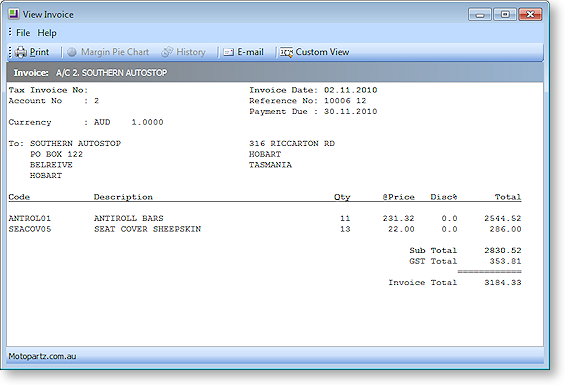Invoice Number Search
Creditor/Debtor account > Transactions tab > ![]()
Clicking the Invoice Search button on the Transactions tab ( ![]() ) or pressing F7 opens the Invoice Search window.
) or pressing F7 opens the Invoice Search window.
The Invoice Search window has a right click menu to giving access to many other windows. This includes 'drilling' to the Account (Debtors or Creditors) where further transactions, reversals or updating of header reference fields may be performed from the transactions tab (if you have sufficient access rights within those windows).

From here you can reprint invoices, credits and receipts. Set search criteria and click Search. The Print buttons are not enabled until you have selected a search item.
The filters to search by Shift and Terminal ID are disabled when the window is set to Creditors mode as they are not applicable.
Field Definitions
The grid header fields are detailed in the table below:
|
Field |
Description |
|
Seqno |
A unique identifier for records in tables. |
|
Entry Time |
The time of the invoice entry. |
|
Inv Date |
The date of the invoice entry. |
|
A/c |
The account number. |
|
InvNo |
The invoice number. |
|
Trans type |
The transaction type, i.e. Invoice or credit note etc. |
|
Name |
The company name of the debtor or creditor. |
|
OutStanding |
Any outstanding amounts for this invoice are listed here. |
|
Tot inc GST |
The total amount that was invoiced, including GST. |
|
Tot exc GST |
The total amount that was invoiced, excluding GST. |
|
Taxtotal |
The total amount that was taxed to this invoice. |
|
Alpha Code |
This is the debtor/creditor code which is normally automatically assigned by the system. Generally this is the first 6 characters of the account name followed by two sequential numerals, starting at 01. |
|
Session_id |
A session id is an integer value (number) which tags all transactions at the time of saving. It's transaction scoped, so when you create an invoice which has invoice line and optional payments, all those transactions get grouped together with the same session id. It's a grouping type of field, i.e. this field gets moved / copied when the source transaction moves through the system. The invoice lines will receive a session_id when saved. The invoice lines required the stock to be decremented, resulting in the creation of a stock transaction, this copies the invoice line session id and then the stock and invoices are posted to the GL. This creates a GL transaction and once again the invoice line session id gets copied. It’s primarily used to ensure that once a source transaction is posted to the GL all its source transactions can be easily identified. |
|
Gatewayno |
This configures EFTPOS / Credit card payment gateway numbers. In MYOB EXO Business you can set up Credit card payment gateways . Like a direct payment service, a web service for the management and handling of payments. As EXO Business can handle multiple payments, it tags the payment debtors lines with the seqno identifying the gateway used. |
|
Eftauth |
This usually contains EFTPOS / Credit Card authorisation / approval codes related to payment gateways. |
|
Eftcaid |
This usually contains a unique EFTPOS computer / terminal id . See POS / EFTPOS whitepaper. |
|
Eftstan |
This usually contains a unique EFTPOS / Credit Card transactional id. See POS / EFTPOS whitepaper |
|
Job# |
Usually a jobcost jobno / jobcode if an invoice came as a result of an EXO Job Costing job. |
Toolbar
|
|
|
|
Print Invoice |
Print Docket |
|
|
|
View Invoice |




